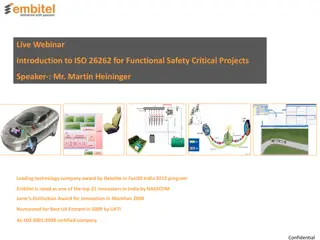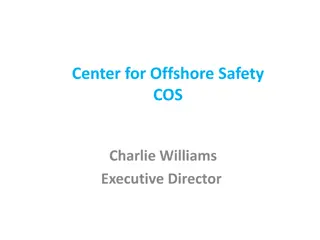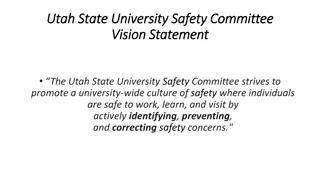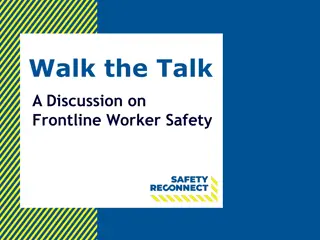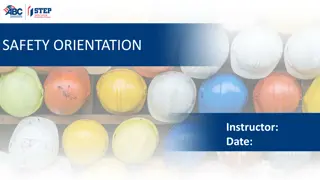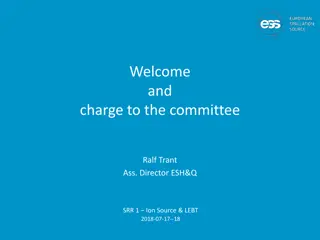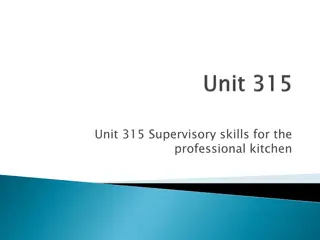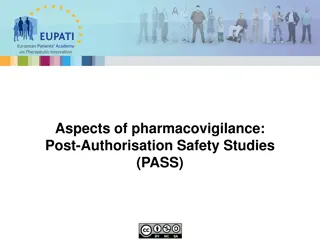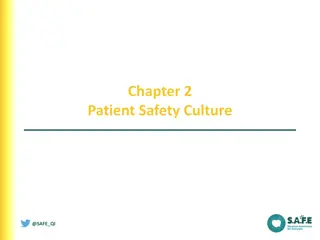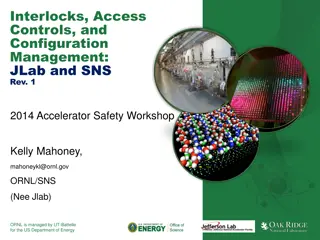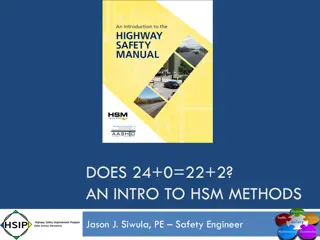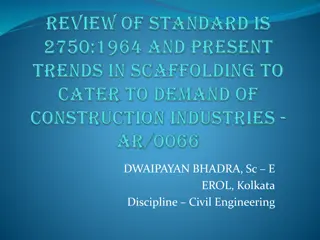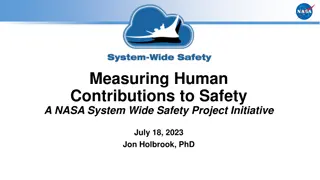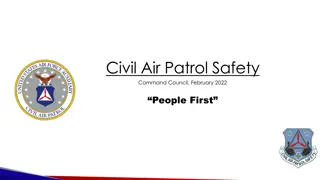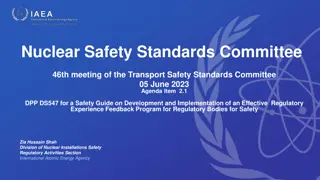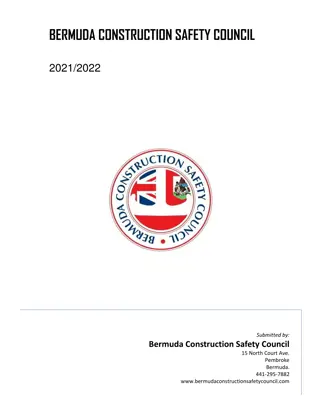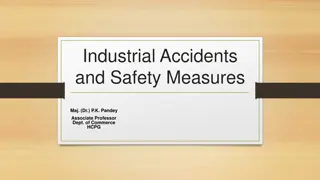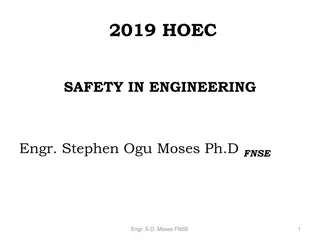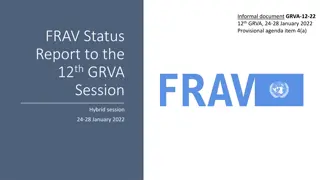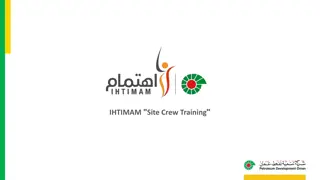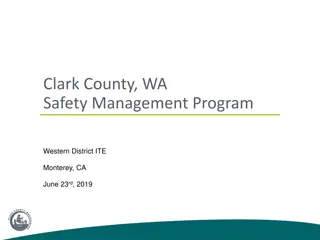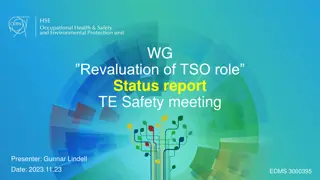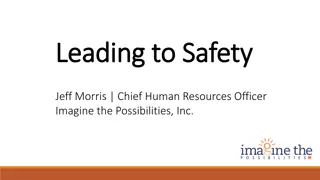Understanding Process Safety Fundamentals in the Industry
Process Safety Fundamentals (PSF) aim to reduce and eliminate fatal and high severity events by providing clear actions for workers. Developed through data analysis, PSF focuses on personal safety and proactive actions. Workers are encouraged to provide feedback on challenges faced in implementing PSF.
Download Presentation

Please find below an Image/Link to download the presentation.
The content on the website is provided AS IS for your information and personal use only. It may not be sold, licensed, or shared on other websites without obtaining consent from the author. Download presentation by click this link. If you encounter any issues during the download, it is possible that the publisher has removed the file from their server.
E N D
Presentation Transcript
Process Safety Fundamentals AN INTRODUCTION 2
What are the Process Safety Fundamentals? Key actions to reduce, and ultimately eliminate, fatal and high severity Process Safety Events (PSE) Support frontline workers Clear Simple Task-level Observable Clearer picture of what Process Safety means in day-to-day activities Proactive Actionable 3
What are the differences? PSF vs Life-Saving Rules Aspect LSR PSF Focus Primary focus on personal safety with some Process Safety overlap Solely focused on Process Safety Flexibility Single common industry set recommended by IOGP Core set recommended by IOGP, with flexibility to supplement or exchange a small number based on local Process Safety challenges 4
How were the PSF developed? We wanted to provide workers in the industry with actions they can take to protect themselves and their colleagues, no matter the worksite Data over ten years (2007-2017) indicates that 128 people lost their lives in 56 Process Safety Events The fundamentals were developed to be data-driven to reduce, if not eliminate, fatal and high severity PSEs Designed PSFs based on 2007-2017 dataset, including Fatal and High Severity PSEs We created 10 Fundamentals with simple icons and clear actions for individuals Tested with IOGP Member Companies workforce representatives and Human Performance experts 5
128 people might still be alive if PSF had been implemented 6
Not another set of rules There will be situations when trying to align with a PSF may prove difficult this is expected. Please tell us about it. You have the knowledge of actually performing the task at the site. If a PSF is difficult or impossible to apply on any one occasion, we want to know so that we can make it possible or easier. Only by bringing these issues into the open can we learn of them and decide what to do. Sometimes it can be a simple fix, sometimes it might be harder, but we are committed to acting every time you us bring us a PSF dilemma. 7
The PSF 8
WE RESPECT HAZARDS We improve our understanding of process safety hazards at our location and our roles in controlling them. We are vigilant about the potential impacts of uncontrolled process safety hazards. We discuss process safety hazards before starting a task. We bring forward process safety hazards to be included in activity risk assessments. 9
WE RESPECT HAZARDS - discussion Additional guidance PS Hazards It s important to understand the process safety hazards at our facilities and be aware of the harm they could cause if we lose control of them can you think of examples? Avoiding risk normalization - When we routinely work close to process safety hazards, it is easy to become desensitized to them what are some hazards that we don t always think about? Alert - Teams are encouraged to be alert for risk assessments that do not cover all the process safety risks associated with an activity how can we make sure we think of these hazards during our day-to-day work? Useful links Energy Institute Reflective Learning video Removing the hazards Step change Major Accident Hazard Understanding videos and tool packs Safer Together videos and other tools 10
WE APPLY PROCEDURES We use operating and maintenance procedures, even if we are familiar with the task. We discuss the key steps within a critical procedure before starting it. We pause before key steps and check readiness to progress. We stop, inform supervision, and avoid workarounds if procedures are missing, unclear, unsafe, or cannot be followed. We take time to become familiar with, and practice, emergency procedures. 11
WE APPLY PROCEDURES - discussion How do we apply procedures? Verify that procedures are up-to-date, effective, and easy to use. Follow up if concerns about a procedure are raised. Become familiar with the plant, its equipment, and its procedures. Keep aware and informed of Emergency Response procedures? Useful links US Chemical Safety Board: Fire in Baton Refuge US Chemical Safety Board: Bayer CropScience Pesticide Waste Tank Explosion Refer to local company guidance on procedures, consider linking to Human Factors guidance 12
WE SUSTAIN BARRIERS We discuss the purpose of hardware and human barriers at our location. We evaluate how our tasks could impact process safety barriers. We speak up when barriers don t feel adequate. We perform our roles in maintaining barrier health and alert supervision to our concerns. We use an approval process for operations with degraded barriers. 13
WE SUSTAIN BARRIERS - discussion How do we sustain barriers? What are the PS barriers at our location? How does my work affect these barriers? Ensure that systematic barrier management processes are in place and that necessary resources are allocated to test and maintain barriers. Implement approved risk reduction measures for degraded or failed barriers and restore barrier functionality as soon as practical. Useful links Energy Institute Reflective Learning - I own my barrier Energy Institute Reflective Learning - I keep my barrier strong 14
WE STAY WITHIN OPERATING LIMITS We discuss and use the approved operating limits for our location. We escalate where we cannot work within operating limits. We alert supervision if an alarm response action is unclear or the time to respond is inadequate. We obtain formal approval before changing operating limits. We confirm that potential for overpressure from temporary pressure sources has been addressed. 15
WE STAY WITHIN OPERATING LIMITS - discussion How do we stay within operating limits? Document SOL (Safe Operating Limit) for key process variables & make them visible to frontline workers Regularly check personnel knowledge & skills to stay within operating limits Systematically investigate excursions outside SOL Demonstrate through decisions that cost, production, or schedule does not override safety Useful links US Chemical Safety Board: Anatomy of Disaster - BP refinery, Texas City US Chemical Safety Board: Airgas Safety Spotlight Centre for Chemical Process Safety: Know the temp capability of your plant - both high and low! 16
WE MAINTAIN SAFE ISOLATION We use isolation plans for the specific task, based on up-to- date information. We raise isolation concerns before the task starts and challenge when isolation plans cannot be executed. We check for residual pressure or process material before breaking containment. We monitor the integrity of isolations regularly and stop to reassess when change could affect an isolation integrity. We confirm leak-tightness before, during, and after reinstating equipment. 17
WE MAINTAIN SAFE ISOLATION - discussion How do we maintain safe isolation? Monitor isolation practice at your location & verify its effectiveness. Implement improvement where issues are identified. Respond and follow up if isolation concerns are raised. Regularly check that those performing isolations are effectively trained and supported Useful links US Chemical Safety Board: Key Lessons for Preventing Incidents during Maintenance US Chemical Safety Board: Explosion & Fire at Williams Olefins Plant, Geismar, Louisiana UK Health & Safety Executive: The safe isolation of plant and equipment 18
WE WALK THE LINE We use up to date documentation (e.g., Piping and Instrumentation Diagrams, or P&IDs) that accurately reflect installed systems and equipment. We physically confirm the system is ready for the intended activity (e.g., valve positions, line up of relief devices, etc.). We alert supervision to identified documentation and readiness issues before operation. 19
WE WALK THE LINE - discussion How do we walk the line? Regularly confirm that process safety information is accurate and up-to-date Discuss walk the line issues with front-line workers and follow up on concerns raised Check that systems are in good condition and correctly set-up each time we start them up or make a significant change in their use. Useful links AIChE: Walk the Line Centre for Chemical Process Safety: Walk the line IOGP Member Company Example: Walk the line 20
WE CONTROL IGNITION SOURCES We identify, eliminate, or control the full range of potential ignition sources during task risk assessments and during job preparation and execution. We minimise and challenge ignition sources even in non- hazardous areas. We eliminate ignition sources during breaking containment and start-up and shutdown operations. 21
WE CONTROL IGNITION SOURCES - discussion How do we control ignition sources? Regularly check that personnel understand the full range of potential ignition sources and the requirements for ignition source control. Control work risk assessments to evaluate the potential for flammable hazards even outside classified/zoned areas shown on the area classification drawing. Report defects in electrical equipment to control potential ignition sources. Useful links Centre for Chemical Process Safety: Managing static - a key part of reducing ignition sources Centre for Chemical Process Safety: Control ignition sources in your plant 22
WE RECOGNISE CHANGE We look for and speak up about change. We discuss changes and involve others to identify the need for management of change (MOC). We review the MOC process for guidance on what triggers an MOC. We discuss and seek advice on change that occurs gradually over time. 23
WE RECOGNISE CHANGE - discussion How do we recognise change? Verify that systematic identification and management of change processes are in place and working effectively. Ensure that workforce personnel and management are trained to recognise change. Teams can review their local MOC process for guidance on what triggers their MOC process and discuss examples at their location. Useful links US Chemical Safety Board: Fire from ice US Chemical Safety Board: Block In Centre for Chemical Process Safety: A minor change can have a big impact! 24
WE STOP IF THE UNEXPECTED OCCURS We discuss the work plan and what signals would tell us it is proceeding as expected. We pause and ask questions when signals and conditions are not as expected. We stop and alert supervision if the activity is not proceeding as expected. 25
WE STOP IF THE UNEXPECTED OCCURS - discussion How do we encourage workers to stop work if the unexpected occurs? Positively recognise people who stop to re-evaluate a task if it is not going as planned. Communicate to frontline workers that they should pause and seek guidance if an activity is not proceeding as expected. Pausing or stopping a task may feel inconvenient at the time but keeping an activity on plan and under control will avoid incidents, keeping people safe, and supporting good business performance. Useful links Centre for Chemical Process Safety: Know when to stop - and when to get help! Scientific Drilling: Stop Work Authority - Protecting our most valuable resources 26
WE WATCH FOR WEAK SIGNALS We proactively look for indicators or signals that suggest future problems. We speak up about potential issues even if we are not sure they are important. We persistently explore the causes of changing indicators or unusual situations. 27
WE WATCH FOR WEAK SIGNALS' - discussion How do we watch for weak signals? Be alert to weak signals and respond proactively when these signals are raised. Do so, even if the signals seem weak/small/unimportant, so that they can be discussed and evaluated. `Weak signals` can be a vital opportunity to act early to avoid and accident, so it is important that they are persistently explored to understand the cause. Useful links Energy Institute Reflective Learning video Chronic unease IOGP Member Company Example: Weak Signals 28
How should I use Process Safety Fundamentals? STOP Toolbox talks & Safety meetings Pre-job planning Last minute risk assessment Post-job reviews Observations & walkabouts Intervention Intervene or stop the work if a PSF is not being followed How are the PSF applicable to the work we are doing today? What do we need to do to follow the PSF? What needs to be in place? Is everything in place, and in good working condition? Did we take all the actions associated with the PSF? What went well? What didn t go well? Is there anything to note for the next time we have to this perform task or work in this area? Can we learn from incidents that involved a PSF not being followed? Have I done all the PSF actions relevant before the job? Is everything as we discussed in the pre-job planning? Are there any Line of Fire hazards or ignition sources we didn t identify? Do you see anyone performing work where a PSF is relevant? Are they following it? Yes? Great, recognise it! No? Intervene! If someone brings up a PSF dilemma, thank them and show them you will take it seriously.
Work does not start until we are all aware of the PSF and can confirm we can follow them throughout We are all authorised to intervene or stop work if we are in any doubt about the safety of an activity or we can't follow the PSF STOP
We are all authorised to intervene or stop work STOP Intervention can be the last opportunity to prevent a process release or a fatality. I know, but it is not always easy to tell someone to stop the job. Exactly, especially if it s your boss! Yeah, but it s better to have an uncomfortable conversation now, than someone getting hurt later.
A closing message Data reported by IOGP Members over a period of ten years (2007-2017) shows that 128 people lost their lives in 56 process safety events. In response to this, the IOGP Process Safety Fundamentals (PSFs) have been developed to support companies as they seek to reduce, and ultimately eliminate, fatal and high severity process safety events. PSF (Process Safety Fundamentals) designed to support those working in front-line operations, maintenance, and on wells teams. They are therefore not intended to exhaustively address all process safety risks and hazards in the oil and gas industry, but to be deployed in addition to company`s underlying Process Safety Management system. 32
Visit our website for www.iogp.org/oil-and-gas-safety/process-safety/fundamentals/ Videos Presentations External resources Posters Get in touch! infoPSF@iogp.org +44 (0)20 3763 9700















